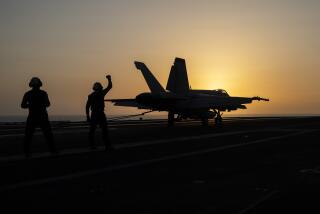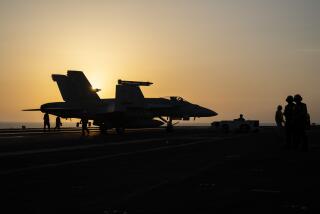U.S. missile kills 6 in Somalia
NAIROBI, KENYA — A U.S. missile strike Monday against suspected terrorists in a remote village of southern Somalia killed at least six people and wounded 10, witnesses and local leaders said.
A Tomahawk cruise missile was launched from a U.S. submarine off the coast of the African nation, U.S. officials said, but they declined to identify the target or provide other details.
It was the fourth U.S. military strike in Somalia since Ethiopian troops entered the country in the Horn of Africa in December 2006 to help defeat Islamist militants who had seized Mogadishu, the capital, and to restore power to a U.N.-recognized transitional government.
Since then, the militants have shifted underground, launching an insurgency that has killed hundreds of Somalis and displaced 600,000. U.S. officials have accused the Islamists of harboring terrorists, including suspects from the 1998 Al Qaeda attacks against U.S. embassies in Kenya and Tanzania.
U.S. officials defended Monday’s attack.
“The United States is going to go after Al Qaeda and Al Qaeda-affiliated operatives wherever we find them,” National Security Council spokesman Gordon Johndroe said aboard Air Force One as President Bush returned to Washington from Texas.
The main target of the strike was believed to be Hassan Turki, one of the leaders of Somalia’s Islamist militias. Turki was cited by the U.S. State Department in 2004 for alleged links to Al Qaeda and is suspected of running military training camps in Somalia.
“The attack was related to the visit of Turki on Sunday, but what they bombarded was a civilian place, not a military base,” said Mahmoud Sheik, a resident of Dobley, the village where the missile strike took place, who was interviewed by telephone.
Local elders said Turki was in Dobley, which is about five miles from the Kenyan border, to mediate a dispute between his militias and government troops, which have been fighting for control of the area.
A U.S. missile or missiles struck two homes in Dobley shortly after midnight. The homes were used as a transfer point for truck shipments of khat, a leafy narcotic substance grown in Kenya and imported daily to Somalia, local leaders said.
“I awoke to heavy explosions and flashes of light,” Said Abdulle, a local elder, said. “It shook my doors and windows. We ran outside and hid in the trees.”
He said those killed appeared to be civilians. Many residents of the town have fled, fearing another U.S. strike.
Somalia has been embroiled in clan-based warfare since the 1991 collapse of a military dictatorship. In recent weeks, violence has shifted from Mogadishu, where thousands of Ethiopian troops continue to occupy the capital, to the countryside.
Last week, as many as 18 government troops were killed in an ambush by insurgents in Dinsor, near Baidoa, according to local officials and insurgent leaders.
Remnants of the Islamic Courts Union, an alliance of religious leaders that was chased from Mogadishu in 2006, have joined forces with a group of opposition leaders living in exile in Eritrea. They have vowed to drive out Ethiopian forces from Somalia and topple the fragile transitional government.
Recently appointed Prime Minister Nur Hassan Hussein has been attempting to negotiate with leaders from Islamist factions and opposition groups to end the violence, but so far little progress has been reported.
Monday’s strike followed similar U.S. attacks last year, in January and June, against suspected militants. In the January attack, military officials said they were targeting Fazul Abdullah Mohammed, who the FBI believes had a role in the 1998 bombings of the U.S. embassies in Nairobi and Dar es Salaam.
He was not killed, officials later confirmed.
--
Times staff writers Julian E. Barnes in Washington and James Gerstenzang aboard Air Force One and a special correspondent in Mogadishu contributed to this report.
More to Read
Sign up for Essential California
The most important California stories and recommendations in your inbox every morning.
You may occasionally receive promotional content from the Los Angeles Times.










